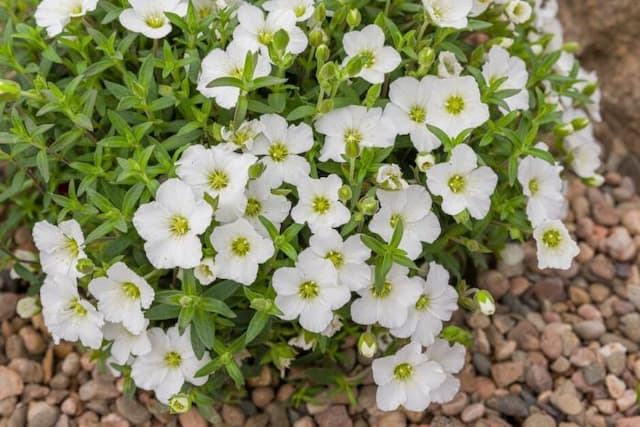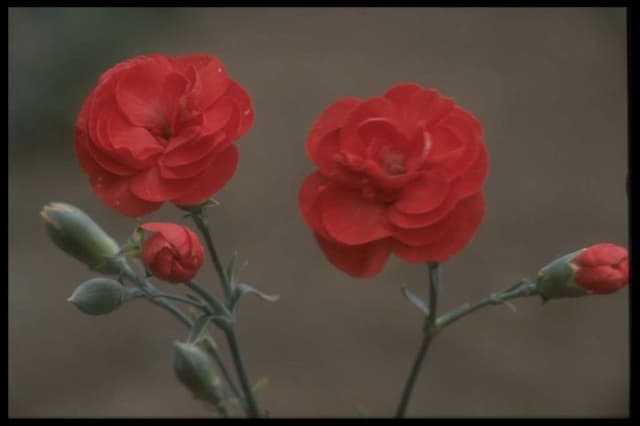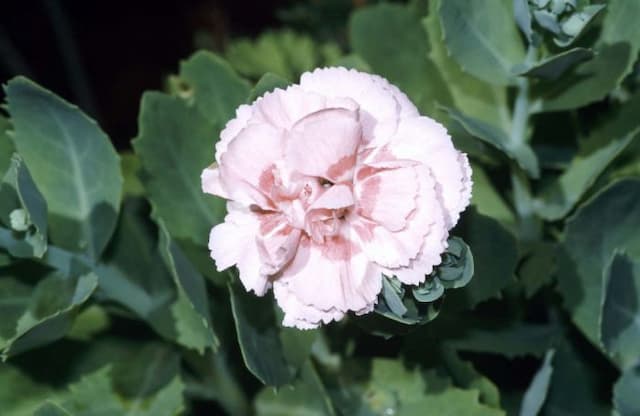Carnation Dianthus 'Dancing Queen' (PBR) (p)

ABOUT
The Dianthus 'Dancing Queen', commonly known as the 'Dancing Queen' pinks, is a beautifully ornamental plant that instantly grabs attention due to its striking flowers. The blossoms exhibit a rich array of colors, typically pink hues that may vary from soft, pastel tones to more intense, vibrant shades. The petals are uniquely fringed or serrated along the edges, adding a sense of texture and visual interest. These petals often feature a pattern of varying colors, with margins that might be a lighter or contrasting color compared to the rest of the petal. The vibrant blooms of the 'Dancing Queen' exude a delightful fragrance, which is often described as sweet and spicy, a characteristic trait of many in the Dianthus family. The foliage of this plant provides a lovely contrast to its showy flowers. The leaves are typically slender, with a blue-green or gray-green color that has a grass-like appearance. These narrow leaves form a dense mat, which serves as a backdrop that enhances the beauty of the flowers. The overall visual impression of the 'Dancing Queen' pinks is that of a charming and colorful clump that provides an eye-catching display, making it a popular choice for gardeners who wish to add a splash of color and a pleasant aroma to their landscapes.
About this plant
 Names
NamesSynonyms
Dancing Queen Carnation, Dancing Queen Pink.
Common names
Dianthus 'Dancing Queen'
 Toxicity
ToxicityTo humans
The Dianthus 'Dancing Queen', commonly known as Carnation, is not considered toxic to humans. These plants are not known for being poisonous, and ingestion of carnation parts typically does not lead to serious health issues. However, eating any non-food plant material can cause discomfort, and sensitive individuals might experience mild gastrointestinal upset. It is always best to avoid ingesting plants that are not meant for consumption to prevent any possible consequences.
To pets
The Dianthus 'Dancing Queen', or Carnation, is considered to have only mild toxicity to pets. While not severely poisonous, if a pet ingests a significant amount of carnation, it might experience mild gastrointestinal upset, including symptoms like vomiting or diarrhea. These symptoms are typically not life-threatening, but if a pet consumes a large amount of the plant or shows significant distress, it is recommended to contact a veterinarian.
 Characteristics
CharacteristicsLife cycle
Perennials
Foliage type
Evergreen
Color of leaves
Blue-green
Flower color
Pink
Height
1 foot 6-12 inches (30-45 cm)
Spread
1 foot 8-12 inches (20-30 cm)
Plant type
Herb
Hardiness zones
5
Native area
Europe
Benefits
 General Benefits
General Benefits- Aesthetic Appeal: Adds vibrant colors and unique patterns to gardens with its frilly edged petals and striking pink coloration.
- Attracts Pollinators: Welcomes beneficial insects such as butterflies and bees, which are vital for pollination.
- Compact Size: Suitable for small spaces, borders, and patio containers due to its compact growing habit.
- Long Blooming Period: Offers an extended display of flowers from late spring to early fall.
- Drought Tolerance: Once established, it is relatively drought-tolerant, requiring minimal watering.
- Low Maintenance: Requires little care beyond occasional deadheading to promote further blooming.
- Cold Hardy: Capable of withstanding cooler temperatures, making it suitable for a variety of climates.
- Versatile Usage: Can be used in rock gardens, as ground cover, or in cottage garden settings.
- Herbaceous Perennial: Comes back year after year, providing a reliable splash of color to the landscape.
- Cut Flowers: Suitable for cutting and use in floral arrangements with its long-lasting blooms.
 Medical Properties
Medical PropertiesThis plant is not used for medical purposes.
 Air-purifying Qualities
Air-purifying QualitiesThis plant is not specifically known for air purifying qualities.
 Other Uses
Other Uses- Dianthus 'Dancing Queen', commonly known as carnation, can be pressed and included in scrapbooking or paper crafts for a touch of natural beauty.
- When dried, carnations can be used to create fragrant potpourri mixtures that add a pleasant aroma to any room.
- Carnation petals can be used to create natural dyes for fabrics, offering a range of colors from light pinks to deep reds depending on the processing.
- Carnations can be used in floral photography, where their vibrant colors and intricate petals provide the perfect subject to practice macro photography skills.
- With their long-lasting qualities, carnations can be included in homemade wreaths and floral decorations that maintain their appearance for an extended period.
- The sturdy stems of carnations make them ideal for use in floral foam arrangements, where they can provide structure and support for more delicate flowers.
- Carnations are often used in educational settings for science experiments that demonstrate capillary action by changing the color of the flowers through dyed water.
- Carnations can be made into a gentle floral water for use in ironing clothes, giving laundry a fresh and mild floral scent.
- The flowers can be floated in decorative bowls of water as part of table centerpieces for weddings and other special events.
- Carnations can be carefully arranged to create living works of art, such as flower mandalas, which are used in various cultural ceremonies and personal meditation practices.
Interesting Facts
 Feng Shui
Feng ShuiThe Carnation is not used in Feng Shui practice.
 Zodiac Sign Compitability
Zodiac Sign CompitabilityThe Carnation is not used in astrology practice.
 Plant Symbolism
Plant Symbolism- Love: Dianthus, commonly known as "carnations" or "pinks," often symbolizes love and fascination, making it a popular choice for romantic occasions.
- Distinction: The name "Dianthus" itself is derived from the Greek words "dios" (god) and "anthos" (flower), which suggests a flower of the gods, symbolizing distinction and divine beauty.
- Pure Affection: Carnations, especially in lighter shades such as pink, can represent pure love and affection, depicting a tender and endearing emotion.
- Boldness: The vibrant colors and patterns of 'Dancing Queen' can symbolize boldness and celebration, fitting for the cultivar's lively name.
- Gratitude: Carnations are also associated with gratitude and appreciation, which makes them a common choice for gifts to express thanks.
- Admiration: With its frilled petals and unique coloration, 'Dancing Queen' can also represent admiration and the fascination one may have for another.
 Water
WaterThe Dianthus 'Dancing Queen', commonly known as Pinks, should be watered thoroughly when the top inch of soil feels dry to the touch. This will typically mean watering once or twice a week, depending on climate conditions and the maturity of the plant. It is important to avoid overhead watering to prevent disease; instead, water at the base of the plant. Young plants will need about one gallon of water per week, while established plants might require slightly more during hot, dry periods. Always ensure that the plant is in well-draining soil to prevent waterlogging, which can lead to root rot.
 Light
LightPinks thrive best in full sun, meaning they require at least six hours of direct sunlight daily. They can tolerate some light shade, especially in the hottest part of the afternoon, but too much shade can result in sparse blooms and leggy plants. The best spot for Pinks would be in a south-facing garden that receives ample sunlight throughout the day.
 Temperature
TemperaturePinks are quite hardy and can tolerate a temperature range from approximately 40°F to 85°F. They perform best in cool to moderate temperature conditions, ideally between 60°F and 70°F. They can endure light frost but prolonged exposure to temperatures below freezing or extremely high heat may damage the plant.
 Pruning
PruningPinks should be pruned to encourage bushy growth and to remove spent blooms, a practice often called deadheading. After the main flush of blooms, lightly trim back the plants by a few inches to stimulate a second bloom period. Regular pruning, especially deadheading, should be done throughout the blooming season. The best time for a more significant prune, to shape the plant or cut back leggy stems, is usually in early spring or after flowering has completed.
 Cleaning
CleaningAs needed
 Soil
SoilCarnations require well-draining, loamy soil enriched with organic matter. A mixture of one part garden soil, one part peat, and one part perlite or sand makes an ideal soil mix. Maintaining soil pH between 6.0 and 7.0 is optimal for carnation health. It’s also beneficial to incorporate a slow-release fertilizer into the soil to support robust growth.
 Repotting
RepottingCarnations like 'Dancing Queen' should be repotted every one to two years to refresh the soil and accommodate root growth. Best done in late winter or early spring, repotting is also an opportunity to divide clumps if the plant has become overcrowded, which helps maintain its vigor.
 Humidity & Misting
Humidity & MistingCarnations, including the 'Dancing Queen' variety, thrive best in moderate humidity conditions. They can tolerate a range from 40% to 60% humidity. They do not require very high humidity but should not be placed in extremely dry environments. Good air circulation is important to prevent any fungal diseases.
 Suitable locations
Suitable locationsIndoor
Place in a bright spot with some direct light.
Outdoor
Full sun or partial shade, sheltered from strong winds.
Hardiness zone
3-9 USDA
 Life cycle
Life cycleThe life of a Dianthus 'Dancing Queen', commonly known as a carnation or pink, begins with seed germination, where the seeds require well-draining soil and usually germinate in light at temperatures around 70°F. Upon sprouting, seedlings grow into juvenile plants with characteristic narrow, green leaves, entering a vegetative stage during which they develop their foliage and root systems. As the plants mature, they enter the flowering stage, typically in late spring to early summer, during which vibrant double flowers bloom, offering shades of pink with unique, fringed petal edges. After pollination, which can be assisted by insects, the plant sets seeds which, if allowed to mature, will be dispersed from the capsule-like fruit, perpetuating the next generation. Throughout the growing season, Dianthus 'Dancing Queen' benefits from deadheading, which encourages further blooming and extends the flowering period. As a perennial, the plant may die back at the end of the growing season, especially in colder climates, but with proper care, it should re-emerge from its root system the following spring.
 Propogation
PropogationPropogation time
Spring-Early Summer
Propogation: The Dianthus 'Dancing Queen', commonly known as the Pink 'Dancing Queen', is typically propagated through cuttings, as this method is popular for maintaining the characteristics of the parent plant. The ideal time for taking cuttings is late spring or early summer when the plant is actively growing. To propagate, choose healthy and non-flowering stems, cutting a length of about 4 to 6 inches (approximately 10 to 15 cm) just below a node. Remove the lower leaves and dip the cut end into a rooting hormone to encourage root development. The stem cutting should then be placed in a well-draining soil mix, ensuring that at least one node is below the soil surface. The environment should be kept humid by covering the cutting with a plastic bag or placing it in a propagator, and kept at a constant temperature of about 70°F (21°C). Roots typically develop within a few weeks, after which the new Pink 'Dancing Queen' plants can be gradually acclimatized to less humid conditions before transplanting.



![Pink [Tequila Sunrise]](/_next/image?url=https%3A%2F%2Fplants-admin.emdemapps.com%2Fimages%2Fplants%2F%2Fimages%2F604b5d995d06e.png&w=640&q=75)





